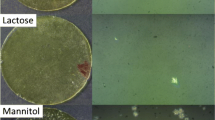Abstract
Purpose
Inhibit the fast surface crystallization of amorphous drugs with gelatin nano-coatings.
Methods
The free surface of amorphous films of indomethacin or nifedipine was coated by a gelatin solution (type A or B) and dried. The coating’s effect on surface crystallization was evaluated. Coating thickness was estimated from mass change after coating.
Results
For indomethacin (weak acid, pKa = 4.5), a gelatin coating of either type deposited at pH 5 and 10 inhibited its fast surface crystal growth. The coating thickness was 20 ± 10 nm. A gelatin coating deposited at pH 3, however, provided no protective effect. These results suggest that an effective gelatin coating does not require that the drug and the polymer have opposite charges. The ineffective pH 3 coating might reflect the poor wetting of indomethacin’s neutral, hydrophobic surface by the coating solution. For nifedipine (weak base, pKa = 2.6), a gelatin coating of either type deposited at pH 5 inhibited its fast surface crystal growth.
Conclusions
Gelatin nano-coatings can be conveniently applied to amorphous drugs from solution to inhibit fast surface crystallization. Unlike strong polyelectrolyte coatings, a protective gelatin coating does not require strict pairing of opposite charges. This could make gelatin coating a versatile, pharmaceutically acceptable coating for stabilizing amorphous drugs.





Similar content being viewed by others
Abbreviations
- IMC:
-
Indomethacin
- NIF:
-
Nifedipine
- PDDA:
-
Poly(dimethyldiallyl ammonium chloride)
- PSS:
-
Sodium poly(styrenesulfonate)
REFERENCES
Hasebe M, Musumeci D, Powell CT, Cai T, Gunn E, Zhu L, et al. Fast surface crystal growth on molecular glasses and its termination by the onset of fluidity. J Phys Chem B. 2014;118:7638–46.
Cai T, Zhu L, Yu L. Crystallization of organic glasses: effects of polymer additives on bulk and surface crystal growth in amorphous nifedipine. Pharm Res. 2011;28:2458–66.
Wu T, Yu L. Surface crystallization of indomethacin below T g. Pharm Res. 2006;23:2350–5.
Zhu L, Wong L, Yu L. Surface-enhanced crystallization of amorphous nifedipine. Mol Pharm. 2008;5:921–6.
Sun Y, Zhu L, Kearns KL, Ediger MD, Yu L. Glasses crystallize rapidly at surfaces by growing crystals upward. Proc Natl Acad Sci U S A. 2011;108:5990–5.
Zhang W, Brian CW, Yu L. Fast surface diffusion of amorphous o-terphenyl and its competition with viscous flow in surface evolution. J Phys Chem B. 2015;119:5071–8.
Yu L. Surface mobility of molecular glasses and its importance in physical stability. Adv Drug Deliv Rev. 2016;100:3–9.
Wu T, Sun Y, Li N, de Villiers MM, Yu L. Inhibiting surface crystallization of amorphous indomethacin by nanocoating. Langmuir. 2007;23:5148–53.
Baghel S, Cathcart H, O’Reilly NJ. Polymeric amorphous solid dispersions: a review of amorphization crystallization, stabilization, solid-state characterization, and aqueous solubilization of biopharmaceutical classification system class II drugs. J Pharm Sci. 2016;105:2527–44.
Theil F, Anantharaman S, Kyeremateng SO, van Lishaut H, Dreis-Kuhne SH, Rosenberg J, et al. Frozen in time: kinetically stabilized amorphous solid dispersions of nifedipine stable after a quarter century of storage. Mol Pharm. 2017;14:183–92.
Barbara F, Merkley VF, Ingar N. Reducing pill burden and helping with medication awareness to improve adherence. Can Pharm J. 2013;146:262–9.
Roew RC, Sheskey PJ, Owem SC. Handbook of pharmaceutical excipients, fifth edition. Great Britain: Pharmaceutical Press; 2006. Print
Miller JM, Blackburn AC, Shi Y, Melzak AJ, Ando HY. semi-empirical relationships between effective mobility, charge, and molecular weight of pharmaceuticals by pressure-assisted capillary electrophoresis: applications in drug discovery. Electrophoresis. 2002;23:2833–41.
Ai H, Jones SA, de Villiers MM, Lvov YM. Nano-encapsulation of furosemide microcrystals for controlled drug release. J Control Release. 2003;86:59–68.
Pargaonkar N, Lvov YM, Li N, Steenekamp JH, de Villiers MM. Controlled release of dexamethasone from microcapsules produced by polyelectrolyte layer-by-layer nanoassembly. Pharm Res. 2005;22:826–35.
Holmes-Farley SR, Bain CD, Whitesides GM. Wetting of functionalized polyethylene film having ionizable organic acids and bases at the polymer-water interface: relations between functional group polarity, extent of ionization, and contact angle with water. Langmuir. 1988;4:921–37.
Bain CD, Whitesides GMA. Study by contact angle of the acid-base behavior of monolayers containing ω-mercaptocarboxylic acids adsorbed on gold: an example of reactive spreading. Langmuir. 1989;5:1370–7.
Whitesides GM, Biebuyck HA, Folkers JP, Prime KL. Acid-base interactions in wetting. J Adhes Sci Technol. 1991;5:57–69.
McDaid DM, Deasy PB. An investigation into the transdermal delivery of nifedipine. Pharm Acta Helv. 1996;71:253–8.
Inagi T, Muramatsu T, Nagni H, Terada H. mechanism of indomethacin partition between n-octanol and water. Chem Pharm Bull. 1981;29:2330–7.
ACKNOWLEDGMENTS
We thank the Bill and Melinda Gates Foundation for financial support and Melgardt de Villiers, Ed Elders, Mark Sacchetti, Niya Bowers, Phil Goliber, and Ellen Harrington for helpful discussions.
Author information
Authors and Affiliations
Corresponding author
Additional information
Guest Editors: Tony Zhou and Tonglei Li
Rights and permissions
About this article
Cite this article
Teerakapibal, R., Gui, Y. & Yu, L. Gelatin Nano-coating for Inhibiting Surface Crystallization of Amorphous Drugs. Pharm Res 35, 23 (2018). https://doi.org/10.1007/s11095-017-2315-z
Received:
Accepted:
Published:
DOI: https://doi.org/10.1007/s11095-017-2315-z




